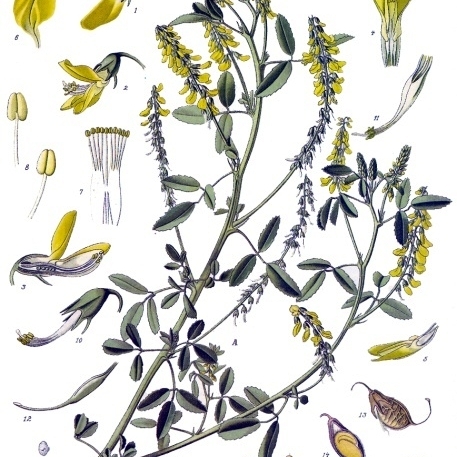Annual or biennial herbs, taprooted, upright. Leaves pinnately 3-foliolate; stipules entire or nearly so, basally adnate to petiole; leaflets serrulate, lateral veins ending in teeth; stipels absent. Racemes axillary, slender, elongate; flowers numerous; bracts minute; bracteoles absent. Calyx teeth subequal. Corolla yellow or white, petals free from staminal tube, deciduous; standard ovate-oblong; wings narrowly oblong; keel broadly falcate. Stamens diadelphous; filaments capillary. Ovary sessile or shortly stipitate; ovules 2-8; style filiform, curved upward, often persistent. Legume obovoid or globose, slightly exserted from calyx, surface reticulate veined or wrinkled. Seeds 1 or 2, broadly ovoid, smooth or papillate.
Annual, biennial or short-lived perennial, procumbent to erect herbs. Lvs pinnately 3-foliolate; principal lateral veins thin and straight, terminating at leaflet margin often in a tooth; stipules adnate to petiole. Infl. axillary, racemose, slender and often lax, few-to many-flowered; bracts present subtending fls, or 0. Calyx teeth 5, subequal, the upper longer. Corolla deciduous after flowering. Vexillary filament free or connate to the middle with the others; anthers uniform. Style glabrous; stigma terminal. Pod indehiscent or tardily 2-valved, ± straight, subglobose or ovoid, not armed, 1-2-seeded, rarely more; seeds estrophiolate, smooth and round in N.Z. spp.
Annual or biennial more or less fragrant herbs. Leaves pinnately 3-foliolate; stipules adnate to the petiole; leaflets toothed. Flowers small, yellow or white, in elongated spike-like axillary racemes; pedicels short; bracts inconspicuous. Calyx-lobes 5, subequal, ± as long as the tube. Corolla glabrous, caducous, free from the stamens. Filaments not dilated, the upper one free from the other 9; anthers uniform. Pod small, 1–2 (–4)-seeded, usually pendulous, longer than the calyx, falling off with the calyx and pedicel.
Petals not adnate to the stamens, glabrous, deciduous; standard subsessile, with 3 major basal veins; wings extended at the upper proximal corner into a small auricle; keel and wings not or loosely interlocked by a wing spur in a keel pocket (both spur and pocket not or weakly developed).
Flowers small, yellow or white, in extended pedunculate axillary racemes, lacking an explosively tripping pollination mechanism; bracts minute or absent; bracteoles absent.
Pod small, subglobose or ovoid, falling off with the calyx and pedicel, indehiscent or tardily dehiscent, variously veined, mostly indehiscent.
Ovary sessile or stipitate, few-ovuled; style long, incurved above, glabrous; stigma minute, terminal, with short papillae on the apex.
Anther sheath straight at the apex; free portions of filaments mostly thin; vexillary filament free; anthers uniform, versatile.
Leaves pinnately 3-foliolate; leaflets toothed, the nerves ending in teeth; stipules basally adnate to the petiole.
Calyx lobes subequal, ± as long as the tube.
Seeds ovoid, smooth or tuberculate.
Annual or biennial herbs.

